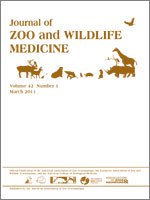Physiologic variables during anesthesia with medetomidine–zolazepam–tiletamine were evaluated in 52 free-ranging brown bears (Ursus arctos) darted from a helicopter and in six captive brown bears darted at a zoo. During anesthesia, rectal temperature, respiratory rate, heart rate, and pulse oximetry derived hemoglobin oxygen saturation were recorded. Arterial blood samples were collected and immediately analyzed for evaluation of pulmonary gas exchange, acid–base status, and selected hematologic and plasma variables. At the end of anesthesia, atipamezole was administered intramuscularly at five times the medetomidine dose. Capture-induced hyperthermia and lactic acidemia were documented in free-ranging bears. Hypoxemia during anesthesia was documented in both free-ranging and captive bears. In free-ranging bears, rectal temperature, heart rate, lactate, hematocrit, and hemoglobin decreased significantly during anesthesia, whereas partial pressure of arterial carbon dioxide, pH, potassium, and glucose increased. Yearlings had a significantly higher heart rate, pH, base excess, bicarbonate, and glucose, and had a significantly lower rectal temperature, sodium, hematocrit, and hemoglobin when compared with subadult and adult brown bears. In conclusion, alterations in pulmonary gas exchange and acid–base status in brown bears during anesthesia with medetomidine–zolazepam–tiletamine with the doses and capture methods used in this study were identified. Oxygen supplementation is recommended to counteract hypoxemia during anesthesia.
How to translate text using browser tools
1 March 2011
Physiologic Evaluation of Capture and Anesthesia with Medetomidine–Zolazepam–Tiletamine in Brown Bears (Ursus arctos)
Åsa Fahlman,
Jon M. Arnemo,
Jon E. Swenson,
John Pringle,
Sven Brunberg,
Görel Nyman
ACCESS THE FULL ARTICLE
Acid–base status
Anesthesia
Arterial blood gases
brown bear
immobilization
lactate
Ursus arctos





